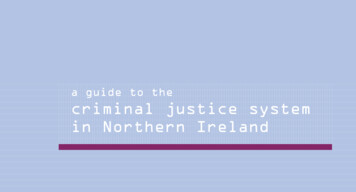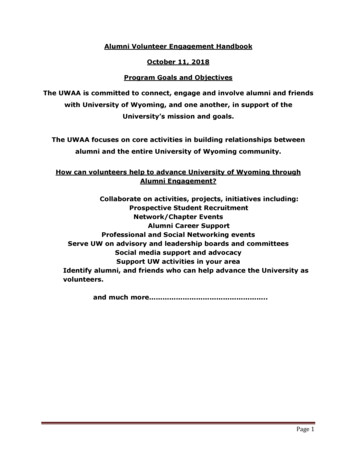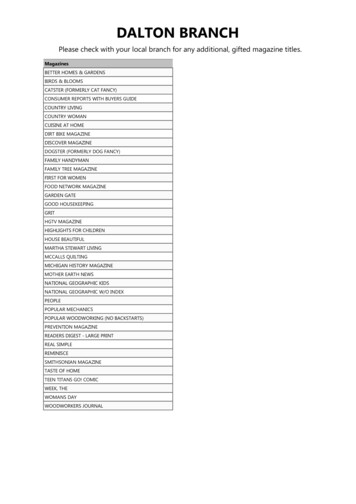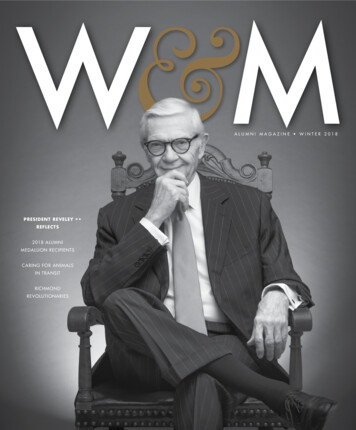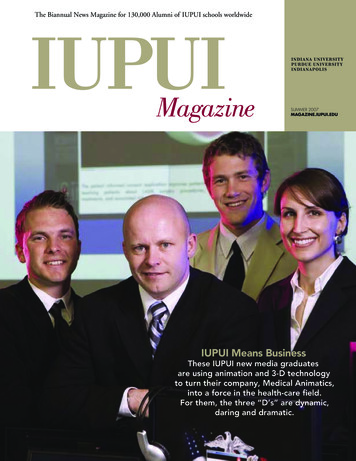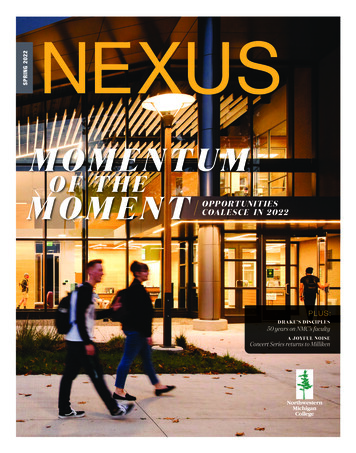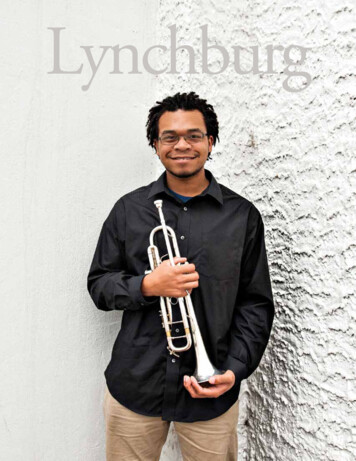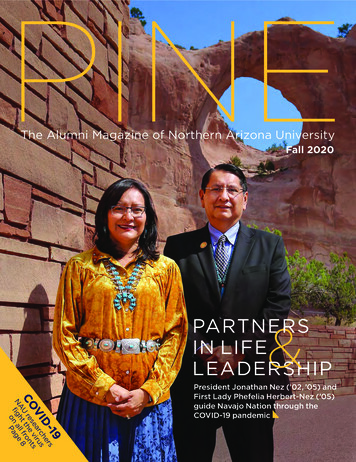
Transcription
The Alumni Magazine of Northern Arizona UniversityFall 202019 rsD- he sVI searcvirutsCOU ret thel fron8NAfighn al ageo PPresident Jonathan Nez (’02, ’05) andFirst Lady Phefelia Herbert-Nez (’05)guide Navajo Nation through theCOVID-19 pandemic
THE VIEW FROM 7,000 FEETTHE RESILIENCEOF LUMBERJACKS“Thank you, Lumberjacks,for rising to the challengeof these unprecedentedtimes. Thank you forseeing there are greatpossibilities ahead.”Honoring sacred landsNorthern Arizona University sits at thebase of the San Francisco Peaks, onhomelands sacred to Native Americansthroughout the region. We honor theirpast, present, and future generations,who have lived here for millennia andwill forever call this place home.I am filled with hope and pride at theunwavering ingenuity, perseverance,and support exhibited byLumberjacks throughout the last fewmonths. In the face of great adversity,the entire NAU family has seized theopportunity to help humanity writea new script—which you can readmore about in the pages that follow.NAU researchers in a wide rangeof disciplines are tackling thepandemic’s many challenges—fromdeveloping a vaccine to tracking thevirus to helping local businessesrecover from the economic impact.Our alumni answered the call, too.Navajo Nation President JonathanNez and First Lady Phefelia HerbertNez, who met at NAU, implementedkey strategies to slow the spread ofCOVID-19 among their constituents.Their tireless work saved countlesslives and garnered national attention.Lumberjacks around the countrytook part in NAU’s online Giving Daythis spring, raising almost 75,000in emergency funds in just 24 hoursto help students, faculty, and staff inneed. We also logged more than 260The Alumni Magazine of Northern Arizona University Fall 2020#AxeOfKindness—from sendingmessages to students to volunteeringat a local food bank. I am trulyhumbled and inspired to see such anoutpouring of support.And there is more exciting—andnon-pandemic!—news to share.Congratulations to the entireNAU community for our first-evernational Best Colleges ranking fromU.S. News & World Report. The 2021Best Colleges Rankings lists NAU atNo. 144 for top public schools—atestament to our momentum asan institution and the outstandingeducation we provide.On the leadership front, wewelcomed Ashok Subramanian,dean of The W. A. Franke College ofBusiness; Andy Wang, dean of theCollege of Engineering, Informatics,and Applied Sciences; RogerBounds, interim dean of the Collegeof Health and Human Services; andJohn Masserini, interim dean of theCollege of Social and BehavioralSciences. These appointments willensure we continue to build ouracademic reputation.Thank you, Lumberjacks, forrising to the challenge of theseunprecedented times. Thank you forseeing there are great possibilitiesahead. And thank you for keepingNAU close to your hearts.Stay safe, and be well.Sincerely,Rita Hartung Cheng, PhDPresident, Northern Arizona UniversityFall 2020313Everyone belongsPower coupleNAU builds on its tradition ofwarmly welcoming all people.Alumni Jonathan Nez and PhefeliaHerbert-Nez are leading NavajoNation to a brighter future.6Jacks adaptNAU takes an innovative approachto fall semester classes.816New game planFour student-athletes show theirresilience in a disrupted season.NAU vs. COVID18The university is fighting on everyfront in the battle against thecoronavirus.Catch up with your fellow alumni—and share your own story.Class notesOn the cover: NAU graduates Jonathan Nez (’02, ’05) and Phefelia Herbert-Nez(’05). (Photo: The Navajo Nation Office of the President and Vice President).On this page: Classes this fall are being taught through NAUFlex, with somestudents attending in person while others participate remotely.Photography: Josh Biggs, Geoff Lambeth, Steven Toya. Pages 14–15, Getty Images.Contributors: Kerry Bennett, Megan Connolly, Kate Elliott, Uri Farkas, HannahFontes, Kyrie Fry, Abigail Gripman, Beth Hickey, Jessica Lawless, Ron Lee, MarkMatthews, Mary McGee, Jane Muller, Tessa North, Amy Phillips, Shannan Rice, TracyKile Schwartz, Mandy Watkins, RenSu Yang.Contact us: Pine is published twice a year by NAU Advancement Foundation.928-523-3757 alumni@nau.edu Stephanie Smith, Director of Alumni EngagementTo join our mailing list, update your contact information online at foundationnau.org.NAU is committed to the health and safety of students, faculty, and staff and followsCDC guidelines on COVID-19. Not every photo in this publication will representthese guidelines, as we aim to accurately present the NAU experience and balancethat need with imagery that reflects the COVID-19 policies we have in place.Visit nau.edu/jacksareback for our current campus health safety guidelines.NAU is an Equal Opportunity/Affirmative Action institution.
TALK TO USThe class ofUNIVERSITY NEWS2020 takes offNAU Online:Helping herfulfill a dreamSince the pandemic began, NAU students, faculty, staff, alumni, and donorshave consistently shown Lumberjack resilience, tenacity, and generosity.Our community came together last spring and again this fall to show theclass of 2020 that Lumberjacks everywhere support and stand with them.The alumni family welcomes them with #LumberjackPride as they go onto achieve their aspirations.NAU professor Gabriel MontañoINCREASINGDIVERSITYStay strong in these uncertaintimes, Lumberjacks. Stayconnected to family, friends,and loved ones. Reach out andhelp one another. You arenot alone!John Ryan ’76One day in Flagstaff could bea blizzard, and the next dayis sunny and crystal blue. Thestorm clouds WILL pass. Youare resilient! You are amazing!You are a Lumberjack!No matter the challenge ordistance, Lumberjacks will finish#NAUStrong!Michael Swinarski ’99The Lumberjack spirit is doingwhat we can to help each otherwhen times are hard. If we canall give, even a little, we will getthrough these difficult timestogether. Go Jacks!Mitch StrohmanThe Voice of the Lumberjacks#AxeOfKindness are important,maybe now more than ever.They encourage our currentgeneration of Lumberjacks tokeep pushing forward and reachtheir aspirations.Cory Holland ’10, ’15, ’16Congratulations, class of 2020!Be proud of your achievements—you have earned this! Best ofluck in all your future endeavors.Dana Oden-Stiglitz ’10Mark Sanders ’97Letters to the editorMore on #AxeOfKindnessHow has NAU helped you realize your aspirations? Tell us for a chance to befeatured in the next issue. Share your story at nau.edu/aspirations.Read more stories about#AxeOfKindness from theLumberjack community atfoundationnau.org/givingday.Follow the NAU Alumni Association @NAUAlumni2The Alumni Magazine of Northern Arizona University Fall 2020NAU professor Gabriel Montaño hasspent his entire career working toimprove diversity in the STEM fields.He routinely speaks at conferencesabout his experience as a Hispanicresearcher, and he’s a past presidentof the largest professional society forunderrepresented scientists.That background—plus a passionfor bringing about change—makesMontaño the perfect person to serveas NAU’s first Chief Diversity Fellow.In his role, Montaño leads alldiversity and inclusion efforts atNAU. His primary goal is to createa university infrastructure thatvalues diversity at all levels—fromundergraduate students to tenuredprofessors to top administrators.“If you want to create change, youhave to create a culture shift,” he said.“Just having representation at onelevel isn’t enough. You need to haveit everywhere.”To help implement its new DiversityStrategic Plan, the university iscreating a Diversity Fellows Program,which Montaño will oversee.The program will be made up ofroughly a dozen people—chosenfrom NAU faculty, students, andstaff—who will work with collegesand departments. The first group ofTrue meaningThere’s a difference between diversityand inclusion, said Gabriel Montaño,NAU’s Chief Diversity Fellow anda professor of applied physics andmaterials science. “Diversity is beinginvited to the meeting. Inclusion isbeing asked to participate.” Trueinclusion welcomes perspectivesfrom all people, he said, regardlessof race, ethnicity, religion, disability,and sexual and gender identities.fellows will start early next year.“The fellows will be the keepers ofthe Diversity Strategic Plan and serveas subject experts,” Montaño said.Under President Rita HartungCheng, NAU has increased diversityamong students and faculty, andit is one of the few colleges in thecountry that includes Native Americaninitiatives in its strategic goals. But theuniversity is committed to doing evenmore, Montaño said, to better reflectthe demographics of the state.“We live in a place with such a richcombination of cultures,” he said. “It’ssuch a melting pot. Diversity shouldbe a huge part of who we are. Weshould look like Arizona.”Marvol Barnard(BA PublicAdministration,’19) is a rolemodel for alladult learners.She returnedto college in her 50s—whilemaintaining her professional andpersonal responsibilities—andcompleted a bachelor’s degreethrough NAU Online. But she’s notdone yet. She’s now in the Master ofOrganizational Leadership program.“It’s not easy, as an olderstudent, to get up the courage toreturn to school,” she said. “Butmy experience at NAU was sowonderful, so fulfilling, and trulylife-changing.”As an online student, workingfrom her home in Green Valley,Arizona, Barnard was able to workand keep leadership roles in theLadies Professional Golf Association(LPGA). In 2019, she was electedNational President of the LPGA.Despite her busy schedule, shemaintained a 4.00 GPA and wasalso honored with the DistinguishedSenior Award at her undergraduatecommencement ceremony.“I have learned so much, my mindhas been so opened, and a love forlearning has been enhanced like Icould have never imagined,” Barnardsaid. “NAU is helping me fulfill adream, and no one can ever knowwhat that means to me.”Two optionsNAU offers several bachelor’s,master’s, and doctoral degreescompletely online. The programsare fully accredited and offeredin two formats. T raditional online learning:Take semester-based courseswith set deadlines P ersonalized online learning:Choose a start date and work atyour own paceLearn more at nau.edu/online.3
UNIVERSITY NEWSSUPER JACKSPlanetary scientistbreaks new groundwith Mission HopeNAU’s Christopher Edwards, assistantprofessor in the Department ofAstronomy and Planetary Science,has been studying Mars for years.He’s worked on multiple NASAmissions to the Red Planet andleads the university’s Mars RoverOperations and Analysis Laboratory.This summer, he made scientifichistory as part of the Emirates MarsMission Hope orbiter team—the Arabworld’s first interplanetary mission.Edwards serves as an instrumentscientist on the project, workingwith engineers from the United ArabEmirates Mohammed bin RashidSpace Centre and Arizona StateUniversity. Together, they developeda new instrument to study the lowerand middle atmosphere of theplanet, which Hope should reach inFebruary. Theorbiter willthen spendthe next twoyears collectingimages anddata as itorbits Mars.A quantum leap ininternet researchNAU is working on a new initiativeto help establish the Center forQuantum Networks, or CQN.CQN aims to lay the foundationsof the quantum internet, which willrevolutionize communication andcomputing. NAU is collaboratingwith the University of Arizona, thelead institution on the project, andwill receive nearly 2 million infunding as a contributing partner inthe areas of research, education, andworkforce development.The project started this fall and isNAU’s first participation in a NationalScience Foundation-designatedEngineering Research Center.Learn more about other NAUbreakthroughs and discoveries atnau.edu/research.4Students, recent graduates take home prestigious honorsNSF FELLOWSGOLDWATER SCHOLARSThese four were chosen for theNational Science Foundation’sGraduate Research FellowshipProgram, which providesfunding for students earningadvanced STEM degrees.Schuyler Borges,Chang Xu works on a project aspart of the 1 2 1 dual-degreeprogram between NAU and herhome university in China.NAU, NUA, and action!Recent grad Chang Xu experienceda new world when she came to NAUfrom China two years ago.She survived a sizable snowstormin 2019. She realized, after observingher American classmates, how manystrange sitting positions existed.Most important, she learned how toexpress herself.“Chinese students are generallymore reserved,” she said, “but aftercoming to NAU, I saw that manyAmerican students were braveenough to express themselves. SoI did, too. It’s a good change.”Xu is one of more than 40 studentswho came to NAU from China as thefirst cohort of the 1 2 1 program.While in Flagstaff, students learnabout all things film: writing, lighting,editing, post-production, and more.And they take a full load: 54 credits inCreative Media and Film (CMF) plus22 elective credits.For Xu—who graduated virtuallyfrom NAU in May with 26 of herclassmates—the hard work paid off.“My favorite part was my capstonefilm,” she said. “It was my first time asa director. From the conception to theshooting and the final cut, I watchedthe story improve. I learned so muchThe Alumni Magazine of Northern Arizona University Fall 2020and I’m grateful to my NAU professorsfor their patience and help.”Paul Helford, CMF principallecturer and the faculty coordinatorfor Asian Academic Engagement,serves as a mentor to the Chinesestudents. But over the years, he’slearned from the experience as well.“Any international exchangeprogram is going to afford thatstudent an experience that willmake his or her life richer,”Helford said. “But when I watch ourChinese students and Americanstudents working together, or whenI communicate with my Chinesecolleagues, what I think about is theimportance of personal relationshipsthat will last a lifetime.”About the programThe 1 2 1 dual-degree programallows students in China to takeclasses at Nanjing University of Arts(NUA) for a year, transfer to NAUfor two years, and then return homefor their final year of school. Whenthey complete the program, studentsearn two degrees: one from NUAand one from NAU.a doctoral studentin astronomy andplanetary sciences,is leading a projectcomparing rocksin Antarcticathat look similarto those in hot springs all over theworld—and are comparable to featureson Mars. Researchers believe theMartian features may be evidence oflife on the Red Planet.Kelly Jaenecke,a master’s studentin ecology, isworking with thePathogen andMicrobiomeInstitute to examinediets of Hawaiianbirds. Her work will help researchersunderstand how diet may be impactedby changes to habitat, including theloss of forest to a deadly pathogen.Jay Kueny (BSAstronomy, ’19) isa master’s studentstudying asteroidsthat have tails, atrait that’s normalfor comets butrare for asteroids.These so-called active asteroids mayhold the secret to the origin of wateron Earth; they also could providewater reservoirs for space missions.Alexis Riche, adoctoral student ingeology, is studyingthe mysteriesbehind theformation of theColorado Plateau.She’s hoping toanswer, for example, why the regionthat spans the Four Corners has anelevation of over 6,000 feet—higherthan surrounding areas.Two NAU students werenamed Goldwater Scholars—the top award in the UnitedStates for undergraduatesin the STEM fields.Breezy BrockBeau PrinceBreezy Brock, a junior majoring inmicrobiology, conducts research at thePathogen and Microbiome Institute.After she graduates, Brock plans toearn a PhD in microbiology and alsoattend veterinary school.Beau Prince, a senior studyingmathematics, physics, and astronomy,conducts planetary research withfaculty mentor Mark Loeffler. He wasalso a member of two NAU crosscountry national championship teams.FULBRIGHT SCHOLARSThree NAU students were selected for the Fulbright US StudentProgram, the preeminent international exchange program for UScitizens and nationals who want to study or teach abroad.Stephanie Paul, whois in the Master of Artsin Teaching Spanishprogram, will teachEnglish at a Colombianuniversity. She’ll alsowork on a secondary project—educating others about how individualdeeds can add up to large-scale actionin fighting climate change.Sierra Pritchard(BA English, ’19) willbe a teacher’s assistantfor an English class inGermany, instructingstudents between theelementary and secondary schoollevels. Pritchard, who was a member ofthe Honors College at NAU, minored inGerman and spent a semester abroadduring her sophomore year.Jayne Sandoval, aGold Axe winner whograduated in 2020 withdegrees in mechanicalengineering andcomparative culturalstudies, will study in Taiwan for hermaster’s in energy engineering. Amember of Navajo Nation, she hopesto preserve tribal land throughrenewable energy.5
POPPINGUP ONCAMPUSCOVID-19 has changed theway we live. That includeslife on campus for students,faculty, and staff whoreturned to Flagstaff this fall.SMART KIOSKSTEMPS IN 3, 2, 1 .Several no-touch kiosks have been installedoutside busy locations throughout campus.These mobile units allow students to talkto a real person, ask questions, and checkin for appointments—all while maintainingphysical distancing.Three dozen high-tech temperature-sensingstations are being used across campus andinside residence halls. They can measurea user’s temperature in three seconds toscreen access to buildings and help limit thespread of COVID-19.Information shown here is current as ofOctober. It could change as public healthguidelines are updated.6MASKS AND TESTSFLEXIBLE LEARNINGGEARING UPMOBILE SOLUTIONSEveryone on campus must wear a maskwhen inside and when they can’t maintainproper physical distancing outside.On-campus COVID-19 testing is available,including mitigation testing on randomlyselected students, faculty, and staff.In the spring, students and faculty quicklyswitched to online learning. This fall, they’vecontinued to adapt as classes are beingtaught using NAUFlex, a hybrid modelthat alternates between in-person andremote instruction.Everyone on campus received a care kit,while faculty were also given high-gradepersonal protective equipment. Donors tothe NAU Foundation provided funding forNAU’s Wearable Informatics Lab to 3D-printface shields for local healthcare workers.The NAUgo app now has a COVID-19 modulewith news and updates. Other apps: NAUHealthcheck, which lets people reportsymptoms and get prevention and screeninginformation; and COVID Watch, which helpswith contact tracing.The Alumni Magazine of Northern Arizona University Fall 20207
MiguelJosé YacamánCreating amore accurateCOVID-19 test.JulieBaldwinMappingCOVID-19 in ruralArizona.C. tingoutbreaksthroughwastewater.From the beginning of the pandemic, NAU’s path forwardhas been clear: deploy world-class researchers, strengthencommunity partnerships, and positively impact lives withour decisiveness, resilience, and courage.8The Alumni Magazine of Northern Arizona University Fall 20209
The COVID-19 crisis has many“Creating and preservingopportunities forArizona’s businessesis central to theNAU mission.fronts—and NAU has the people, places, and purposeto lead on all of them. While one team is exploringtherapeutic material for a vaccine, another is mapping thespread of the disease, and yet another is finding solutionsto the pandemic’s countless disruptions to daily life. Andthrough it all, NAU is partnering with local leaders toprovide free testing and support across the region.EPI DirectorJoseph Guzman”The search for a vaccineNAU’s Pathogen and Microbiome Institute (PMI) is rarelyquiet. Its biosafety level 3 (BSL-3) labs have housedlifesaving research on anthrax, plague, West Nile virus,and more. But this spring, it became ground zero for aBenmassive, multinationaleffort to stop COVID-19.RuddellC. Todd French, an expert in pathogen virulence,is helping to leadConnectingthat effort. “I was excited to joincommunitiesPMI in January,” he said. “It has a rare combinationto scarceof vision, flexibility,excellent leadership, and uniqueresources.biocontainment facilities.”Most universities need to build expensive, high-techlabs before dangerous samples can be safely studied.NAU already had that infrastructure built in.French leads NAU’s new COVID-19 testing site, whichexplores therapeutic agents that could lead to a vaccine.One study involves the cancer drug 2X-121, which Frenchand PMI Executive Director and Regents’ Professor PaulKeim (’77, ’13) are investigating with the Danish firmOncology Venture. Keim and French are also workingwith scientists at Vault Pharma to test a vaccine that usesgenetically modified nanoparticles for drug delivery.NAU’s long history in pathogen research and genomicanalysis makes it a natural leader—one that other expertsBenRuddellConnectingcommunitiesto scarceresources.“We’re much betteroff today than wewere six months ago.Eventually, we will beatthis virus.”Assistant ProfessorC. Todd Frenchto develop an early warning system for future outbreaks,and also to identify cases in asymptomatic people whomight not think to get traditional tests.Other NAU faculty like Professor Kevin Gurney aremapping COVID-19 cases against behavior patternsto determine the most effective ways to stem the virus.As national stay-at-home orders expired, he identifiedwhich regions of the country were able to increase trafficwithout increasing COVID-19 cases. This suggests theother containment policies in those areas are effective,giving the rest of the country a model to follow.Identifying what policies work is especially importantin rural Arizona, where the pandemic’s effect has beensignificant. But, as Regents’ Professor and Director of theCenter for Health Equity Research (CHER) Julie Baldwinobserved, “Early modeling efforts were tailored tolarge, dense urban metropolises.” To fill out the picture,Baldwin and her team—including assistant professor JoeMihaljevic and numerous student contact tracers—arecreating a model of COVID-19 spread in rural northernArizona and the Colorado Plateau.“Our model can help identify which factors havethe biggest impact on viral spread,” said Baldwin. “Isare eager to partner with. These partners includethe Translational Genomics Institute (TGen) and theUniversity of Arizona, who are working with PMI to trackhow COVID-19 evolves and spreads.“In terms of treatments, we’re much better off todaythan we were six months ago,” said French. “Andeveryone at NAU is working together and moving fast.Eventually, we will beat this virus.”Testing and trackingPresidentRita HartungChengLeading byexample.10Elsewhere at NAU, researchers are pushing back againstthe pandemic in a different way: by improving testing andtracking capabilities.Many existing COVID-19 tests are expensive, difficultto produce, and prone to false negatives. NAU professorMiguel José Yacamán and his team are working to changethat. Their innovative, physics-based test detects howCOVID-19 proteins interact with light—identifying eventiny viral traces with much greater accuracy.Meanwhile, assistant professor Crystal Hepp isexamining wastewater at locations across northernArizona to track viral traces in human waste. The goal isMarkMolinaroBuilding the safekitchen ofthe future.NicoletteTeufel-ShoneCoordinatinglocal rapidresponse efforts.population size a more critical factor, or is it frequency ofmovement? This will help create more accurate modelingearlier for future epidemics.”Ideas driven by dataAnother one of Baldwins’ CHER teams is analyzingthe pandemic’s broader impact on one specificdemographic: caretakers. Sixteen million Americans carefor a family member with Alzheimer’s or dementia, andCOVID-19 has only increased their challenges. Throughfocus groups and surveys, CHER is bringing forward whatfamilies are going through, and using the results to informculturally based support programs.Data-driven research also helps Professor Ben Ruddellmonitor resource distribution. Over the past threeyears, his FEWSION project has mapped food, water,and energy supply chains for every community in theUnited States. But with the pandemic shifting demandand disrupting supply lines, Ruddell’s work has taken onnew urgency.FEWSION is now a critical resource for emergencymanagers, who can use its website to see how disruptionswill trickle down to their communities. Ruddell hopesthe data will also help policymakers build more resilientsupply chains going forward.NAU’s Economic Policy Institute (EPI) is examiningthe pandemic’s impact on the economy. During the mostrestrictive stay-at-home orders, EPI released regularsurveys tracking how local business owners are feeling.By doing so, EPI amplified business-owners’ voices andhelped the government support hard-hit economic sectors.“We’ve seen extraordinary resilience from Flagstaff’ssmall businesses,” said EPI Director Joseph Guzman.11
“That’s not to say they don’t have extreme challenges—they do. But their tenacity shouldn’t be underestimated.Creating and preserving opportunities for thesebusinesses is central to the NAU mission.”Serving food serviceRestaurants are critical to the Flagstaff economy—andamong the hardest-hit businesses. To help restoreconsumer confidence, NAU developed a set of pandemicrelated food safety techniques that became the newCOVID Aware Enhanced Food Handler’s Certification.The techniques are being taught in the School ofHospitality and Restaurant Management (HRM)’skitchen classrooms, and faculty have given numerouspresentations to local restaurant groups. Restaurateurscan train and test for certification online and display thecertificate to their customers at no cost.“We’re trying to be the safe kitchen of the future,” saidChef Mark Molinaro, interim associate executive directorat HRM. “We want to stay on top of the latest and greatestproducts and processes so we can teach them to ourstudents and our community.”Helping our neighborsOff campus and across the region,NAU is finding ways to rapidlysupport underserved communitiesduring the pandemic.The new Growing in BeautyPartnership Program went fromproposal to reality in less than amonth. Led by NAU’s Institute forHuman Development, Growing inBeauty provided art supplies, games,and activities for Navajo children withdevelopmental delays. It’s a hugehelp for families who couldn’t accessonline learning, or whose needscouldn’t be met via video.Even where online learning ispossible, it’s often harder for somestudents to retain what they learn.To prevent children from fallingbehind, students from the Collegeof Education worked with Phoenixbased Vista College Prep to teachat Vista Virtual, a summer-schoolprogram for low-income students,students of color, and Englishlanguage learners.“Our students were eager to helpensure Phoenix’s vulnerable studentscould keep pace with their peers inwealthier communities,” said RamonaMellott, dean of NAU’s College ofEducation. “It was a great chanceto serve communities we caredeeply about.”12Of course, online learning requires reliable internet—as do so many other basic tasks. And on Navajo Nation,where 60 percent of residents lack internet access, that’sa luxury. In response, NAU has set up Wi-Fi hotspots andhelped expand broadband internet across the Nation,giving tribal communities critical connectivity when theyneed it most.NAU has been part of other rapid-response effortsin Coconino County. In March, students and faculty—including Professor Nicolette Teufel-Shone (’76,’79)—quickly formed a task force to help the countyinvestigate COVID-19 cases, quarantine those infected,and prepare the health system for increased patientvolume. With their expertise in qualitative research andepidemiology, Teufel-Shone’s team boosted the county’sresponse almost immediately.Alumni answer the callNAU faculty aren’t the only ones who’ve made majorstrides in the fight against COVID-19. Lumberjack alumnithroughout Arizona have displayed that same resilience,determination, and drive.As a hospital administratorin Glendale, Arizona, TinaBrucato-Day (’90) helped steerSt. Joseph Westgate MedicalCenter’s Incident CommandIn April, NAU converted its traditionalteam, organizing its surgeGiving Day into Axe of Kindness, anevent that carried the Lumberjackresponse and keeping up withspirit across the country. But becauseshifting guidelines. Brucato-Day,Lumberjacks never rest, Axe of Kindnessan experienced nurse, said herwasn’t a one-day event. It became atop priority was being out in themovement. And it’s still going strong.hospital with her staff, making sureThroughout the COVID-19 pandemic,they were heard and supported.Lumberjack students, alumni, friends,“I always told them, ‘Let’sand supporters have demonstratedbe clear that it’s unclear,’ ”their love for their communities.They’ve shared uplifting messagesBrucato-Day said. “I can’t controland reached out to those in isolation.changing CDC guidelines, but IThey’ve supported local businessescan push a bed or walk a patientand donated blood. They’ve workedto the bathroom. Sometimes theas first responders and in essentialmost helpful thing is just to bejobs. And they’ve given generously toLumberjacks in need.another pair of hands.”Meanwhile, as the pandemicswept through Mesa, Arizona,Assistant City Manager KariKent (’91) took action: Shehelped launch and oversee theMesa CARES program, whichprovides food assistance, grants,raised on Giving Day for NAUtemporary shelter, technologystudent emergency fundsaid, and more to vulnerablepeople in the greater Mesa area.“At NAU, I learned that theNAU students receivedopportunityfor leadershipmicrograntsstands before me every day,”said Kent. “The more we takethose opportunities, the healthier#AxeOfKindness loggedwe are as a community, and thebetter we all are.”Axe of KindnessBy the Numbers 75K703Jonathan Nez and PhefeliaHerbert-Nez met at NAU.Now, the two of them—who have dedicated theirlives to serving others—are leading Navajo Nation.262The Alumni Magazine of Northern Arizona University Fall 20201311 p
The university is fighting on every . front in the battle against the . coronavirus. Fall 2020. THE VIEW FROM 7,000 FEET. The Alumni Magazine of Northern Arizona University . Fall 2020 THE RESILIENCE . OF LUMBERJACKS. Thank you, Lumberjacks, for rising to the challenge . of these unprecedented . times. Thank you for seeing there are great .


